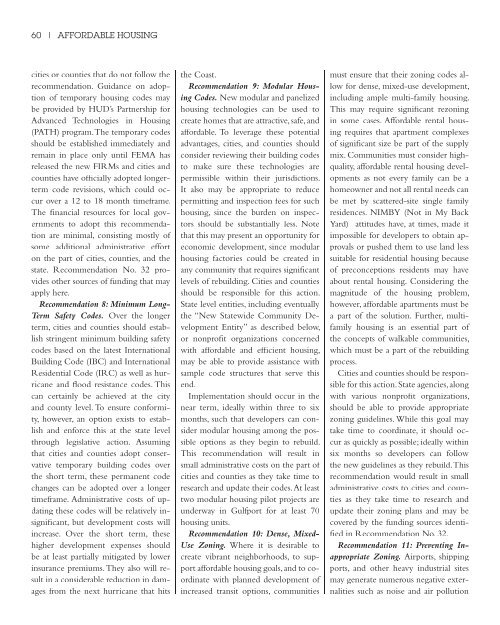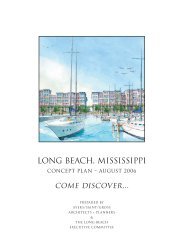Reports - Mississippi Renewal
Reports - Mississippi Renewal
Reports - Mississippi Renewal
- No tags were found...
Create successful ePaper yourself
Turn your PDF publications into a flip-book with our unique Google optimized e-Paper software.
60 | AFFORDABLE HOUSINGcities or counties that do not follow therecommendation. Guidance on adoptionof temporary housing codes maybe provided by HUD’s Partnership forAdvanced Technologies in Housing(PATH) program. The temporary codesshould be established immediately andremain in place only until FEMA hasreleased the new FIRMs and cities andcounties have officially adopted longertermcode revisions, which could occurover a 12 to 18 month timeframe.The financial resources for local governmentsto adopt this recommendationare minimal, consisting mostly ofsome additional administrative efforton the part of cities, counties, and thestate. Recommendation No. 32 providesother sources of funding that mayapply here.Recommendation 8: Minimum Long-Term Safety Codes. Over the longerterm, cities and counties should establishstringent minimum building safetycodes based on the latest InternationalBuilding Code (IBC) and InternationalResidential Code (IRC) as well as hurricaneand flood resistance codes. Thiscan certainly be achieved at the cityand county level. To ensure conformity,however, an option exists to establishand enforce this at the state levelthrough legislative action. Assumingthat cities and counties adopt conservativetemporary building codes overthe short term, these permanent codechanges can be adopted over a longertimeframe. Administrative costs of updatingthese codes will be relatively insignificant,but development costs willincrease. Over the short term, thesehigher development expenses shouldbe at least partially mitigated by lowerinsurance premiums. They also will resultin a considerable reduction in damagesfrom the next hurricane that hitsthe Coast.Recommendation 9: Modular HousingCodes. New modular and panelizedhousing technologies can be used tocreate homes that are attractive, safe, andaffordable. To leverage these potentialadvantages, cities, and counties shouldconsider reviewing their building codesto make sure these technologies arepermissible within their jurisdictions.It also may be appropriate to reducepermitting and inspection fees for suchhousing, since the burden on inspectorsshould be substantially less. Notethat this may present an opportunity foreconomic development, since modularhousing factories could be created inany community that requires significantlevels of rebuilding. Cities and countiesshould be responsible for this action.State level entities, including eventuallythe “New Statewide Community DevelopmentEntity” as described below,or nonprofit organizations concernedwith affordable and efficient housing,may be able to provide assistance withsample code structures that serve thisend.Implementation should occur in thenear term, ideally within three to sixmonths, such that developers can considermodular housing among the possibleoptions as they begin to rebuild.This recommendation will result insmall administrative costs on the part ofcities and counties as they take time toresearch and update their codes. At leasttwo modular housing pilot projects areunderway in Gulfport for at least 70housing units.Recommendation 10: Dense, Mixed-Use Zoning. Where it is desirable tocreate vibrant neighborhoods, to supportaffordable housing goals, and to coordinatewith planned development ofincreased transit options, communitiesmust ensure that their zoning codes allowfor dense, mixed-use development,including ample multi-family housing.This may require significant rezoningin some cases. Affordable rental housingrequires that apartment complexesof significant size be part of the supplymix. Communities must consider highquality,affordable rental housing developmentsas not every family can be ahomeowner and not all rental needs canbe met by scattered-site single familyresidences. NIMBY (Not in My BackYard) attitudes have, at times, made itimpossible for developers to obtain approvalsor pushed them to use land lesssuitable for residential housing becauseof preconceptions residents may haveabout rental housing. Considering themagnitude of the housing problem,however, affordable apartments must bea part of the solution. Further, multifamilyhousing is an essential part ofthe concepts of walkable communities,which must be a part of the rebuildingprocess.Cities and counties should be responsiblefor this action. State agencies, alongwith various nonprofit organizations,should be able to provide appropriatezoning guidelines. While this goal maytake time to coordinate, it should occuras quickly as possible; ideally withinsix months so developers can followthe new guidelines as they rebuild. Thisrecommendation would result in smalladministrative costs to cities and countiesas they take time to research andupdate their zoning plans and may becovered by the funding sources identifiedin Recommendation No. 32.Recommendation 11: Preventing InappropriateZoning. Airports, shippingports, and other heavy industrial sitesmay generate numerous negative externalitiessuch as noise and air pollution




